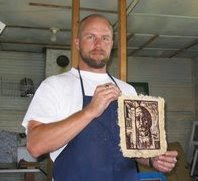I've been mulling over some ideas about artist communities and how I think they should be established. As I work to get my own studio off the ground while earning a regular salary as a high school teacher I wonder how difficult it must be for those fresh out of college. Where would one start? "Flip burgers" or work an empty job just to pay the student loans seems to be the common path though I would propose that the frustration faced by the average artist must be exacerbated when also faced with a dead end job where time spent does little for the future. A far greater guarantee seems to be some sort of parental support or other means of income such as that enjoyed by
Cezanne or
Frankenthaler. This kind of security appears to allow a certain amount of freedom as both Cezanne and Frankethaler were able to pursue new ways of making art without initial commercial success. I can't help but wonder if Frankenthaler might not have painting happy little trees in an impressionist manner if she depended on the sales of her work for the food on her table. If that were the case she may have stayed "safe" rather than risk being sorry for her large color stain paintings. (I don't think she was "sorry," probably just the opposite, I am just trying draw attention to the risks an artist faces when exploring individual expression.) Now if security is not available from some preexisting source as in these last two cases it must be made up by the first, that is unless the community is willing to accept some of this risk faced by artists.
Why would a community even want to accept some of this risk? I mean, does the accept any risk for its other members? Sure it does! Tax breaks are often advertised to businesses to relocate to a community. Local newspapers promote new business as if they were real news items all the time. These are just a couple of examples of the risk as it is accepted by the community for the sake of its members. Of course it is the community in general that benefits from the acceptance of some of these "risky" endeavors: Jobs are created, the tax base is expanded so additional services and civic works can be completed, and of course citizens hear about a lot of tasty new restaurants that open up.
"What about art?" you might ask. Why would a community accept the risk inherent in any new art form? Why should we care if an artist sinks or swims? The answer to that lies in humanity itself- that is the big answer- in that as human beings we derive a large part of our lifes quality from the things we see around us. Proof for this can be found in the cars we drive, the shoes we wear, and the shape of the cell phone we keep on our being at all times. "Sure." you might say, "but those are things we need and as we all know "art is useless." (I'm not saying that, Andy Warhol did- besides that would contradict myself- ooh, sorry, almost another quote, I'll try to stop myself) "Form always follows function" you might say but I say, "function fills a need that's true, but form sells- form is what we
want!" So, in short, by having artists around we get what we want and that promotes a greater quality of life. (Was that too much of a jump to the simplistic? Probably.) Therefor, most artists need communities and communities want artists.
Now it is important for me to admit ignorance on the details of many communities though I am familiar with a few and I have, at least a bit of information on a number of civic programs to promote the arts in communities in my area of the United States. Artists need three things for initial establishment assuming, of course, their work is of reasonable merit (this is not required, however). I think I'll focus on these three things in my next few posts: I want to look at each one in some depth to explain what I think is needed and what a community can do to promote a healthy environment for the arts to develop.
 'Thought I'd post a couple of sketches completed the 17th of February. That evening I felt like drawing but had little specific inspiration so, on a whim, I thought I'd work a bit on a couple of portraits. Both are fine examples of why a person should check their proportions before working through the drawings! Oh well, lesson learned (and likely doomed to be repeated as some point in time). The first is a generic soldier as the war in Iraq is seldom far from consciousness and the second is a portrait of Saelee Oh taken straight out of an edition of Juxtapoz magazine. No particular reason for choosing that picture for a study other than the overall color of the photograph.
'Thought I'd post a couple of sketches completed the 17th of February. That evening I felt like drawing but had little specific inspiration so, on a whim, I thought I'd work a bit on a couple of portraits. Both are fine examples of why a person should check their proportions before working through the drawings! Oh well, lesson learned (and likely doomed to be repeated as some point in time). The first is a generic soldier as the war in Iraq is seldom far from consciousness and the second is a portrait of Saelee Oh taken straight out of an edition of Juxtapoz magazine. No particular reason for choosing that picture for a study other than the overall color of the photograph.
